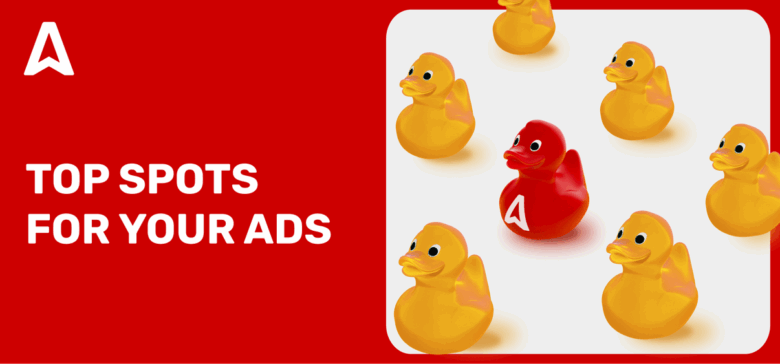Ad placement strategies help publishers increase revenue while enhancing user experience. You get smarter about when you put ad formats and make ads reach the right people. And it’s not just about boosting ad revenue: you’re creating a better experience for visitors.
This guide is a set of tips for how to place Banners, Native ads, In-Page Push, and other formats so they connect with the right audience while you keep gaining high user engagement.
Popular ad placements and their performance
Let’s check some of the universal digital ad placements advertisers run ads with. Each of these is tied to its format.
To recall: an ad format is how the ad looks or appears (mechanics), while placements mean where the ad is shown. Sometimes formats don’t require specific placements (e.g., Popunders).
| Ad Format | Placement Slots | Pros | Cons | Best for |
|---|---|---|---|---|
| Banner Ads | Header, topbar, hero section, sidebar, below the content (footer) | Easy to integrate, strong visibility | Too messy when; can cause banner blindness | News sites, URL shorteners, Image compressors, Translators, etc. |
| Native Ads | In-feed, article midpoints, recommendation widgets | Blend with platform’s content, higher click through rates | Harder to scale manually | Content-heavy publishers; niche blogs (sports, lifestyle) |
| Popunders | Triggered after user action; appears in a new tab; no ad space needed | High conversion for CPA offers; top payouts | Can lower session duration if abused | Streaming, sports blogs, file-sharing platforms |
| In-Page Push Ads | Corner overlays, mobile top banners | Strong for mobile users; no need for audience segmentation | Smaller compared to Interstitials | Multi-vertical publishers; mobile site versions |
| Video Ads | Embedded within articles or videos | Strong engagement, fits video content; high | Requires bandwidth, affects load speed; complex in support; looks poor on smaller screens | Entertainment, gaming, education niches |
| Interstitials | Full-page ad unit; no ad space required | High efficiency; maximum viewers | Can be intrusive for sensitive audiences | Entertainment blogs; multi-page inventory |
| Smartlinks | a URL attached to any text or image | Fit any site; adapt to user interests | Can provoke high bounces when placed on navigation elements | One-page sites, pages with multiple ads are placed |
This list is not complete: many placements are platform-based. Platform-based placements center around specific channels: social networks, search engines, mobile apps, or metaverses. For instance, you’ll meet Auto Ads on Google AdSense only, while Social Bar belongs to Adsterra. Immersive ads are tied to Snapchat, Instagram, or even Metaverses. Interactive formats utilize virtual reality or augmented reality effects and create engaging experiences, outbeating static ads.
Place your ads today and start gaining passive income from ad campaigns on Adsterra. Improved targeting, top formats, and options for any content types.
What are ad placement strategies? A publisher’s guide to success
Ad placement meaning for publishers
Ad placement strategies define how and where you display ads to hit these goals:
- Attract user attention
- Keep user engagement high
- Maximize the revenues you get from site traffic.
Effective ad placement strategies balance resources like viewability, user behavior, and ad formats to make every impression count.
Cross-channel approach
As a publisher, you have multiple channels and devices to consider, from desktop ad placements on wide screens to mobile ad placements on smaller screens. Understanding your target audience’s preferences and matching ad position to content flow is essential.
A road to better performance
Mid-size publishers and large brands approach to placements as to part of a broader range of advertising and monetization strategies. They aim to make informed decisions on:
- Which ad unit performs better on mobile devices, and which strikes with web traffic.
- How to maintain a positive user experience, placing ad content near the editorial.
- Which website ads repel their audience and are better to remove.
- How to gain more clicks while staying not too pushy.
Gaining insights on ad placements leads to better results and conversion rates from ad campaigns connected to your web inventory.
Best ad formats for high-impact placements
There are no right ad formats or bad ad units. It’s all about how you choose, manage, and optimize ad placements. We’ll now observe the best practices of combining positive user experience and lucrative advertising. Let’s start with the brief intro to ad units themselves. And remember to get back to this full guide to web monitezation formats later.
Banners and their types
Different types of Banner ads still generate substantial traffic, especially when sized right. For instance, leaderboard (728×90) and rectangle (300×250) remain the best ad placements for visibility. The formerly popular 468x60px ad type is kind of an outcast today.
Banners take over a significant portion of the screen space, especially on mobile devices, so they can cause user fatigue when placed massively.
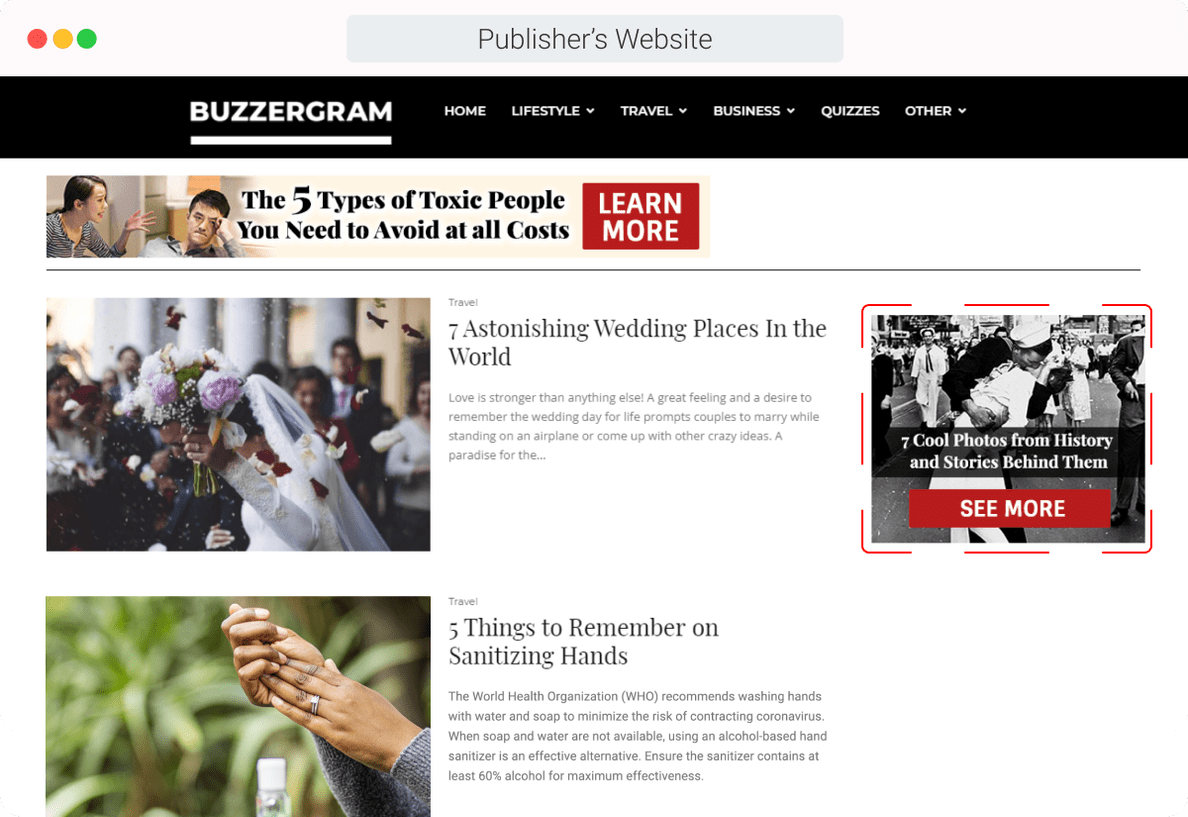
Migrating from AdSense? Try Banner ads or Popunders. When you drive huge traffic, and your readers are not sensitive to ads, these units are top options for online businesses.
Native formats
Native ads blend seamlessly with any content and site’s aesthetics, bypassing ad fatigue. Publishers who resort to native ads, seeding them in the site’s content, report higher engagement metrics.
Sharethrough dropped impressive data: people tend to interact with native formats 53% more frequently than with standard banners. Advertisers prefer native banners when they need to increase CTRs and form brand loyalty.

Popunders, clickunders, and pop-ups
Popunders (clickunders) and pop-ups open up as new browser windows above (up) or below (under) the user’s web page. It’s the best performing ad when aligned with user behavior, for example, during content navigation or after a click. These ads reach mobile audiences efficiently, enhancing exposure without interrupting navigation. One of its’ numerous advantages is their compatibility with any page structure: ads appear outside your pages, no ad space needed.
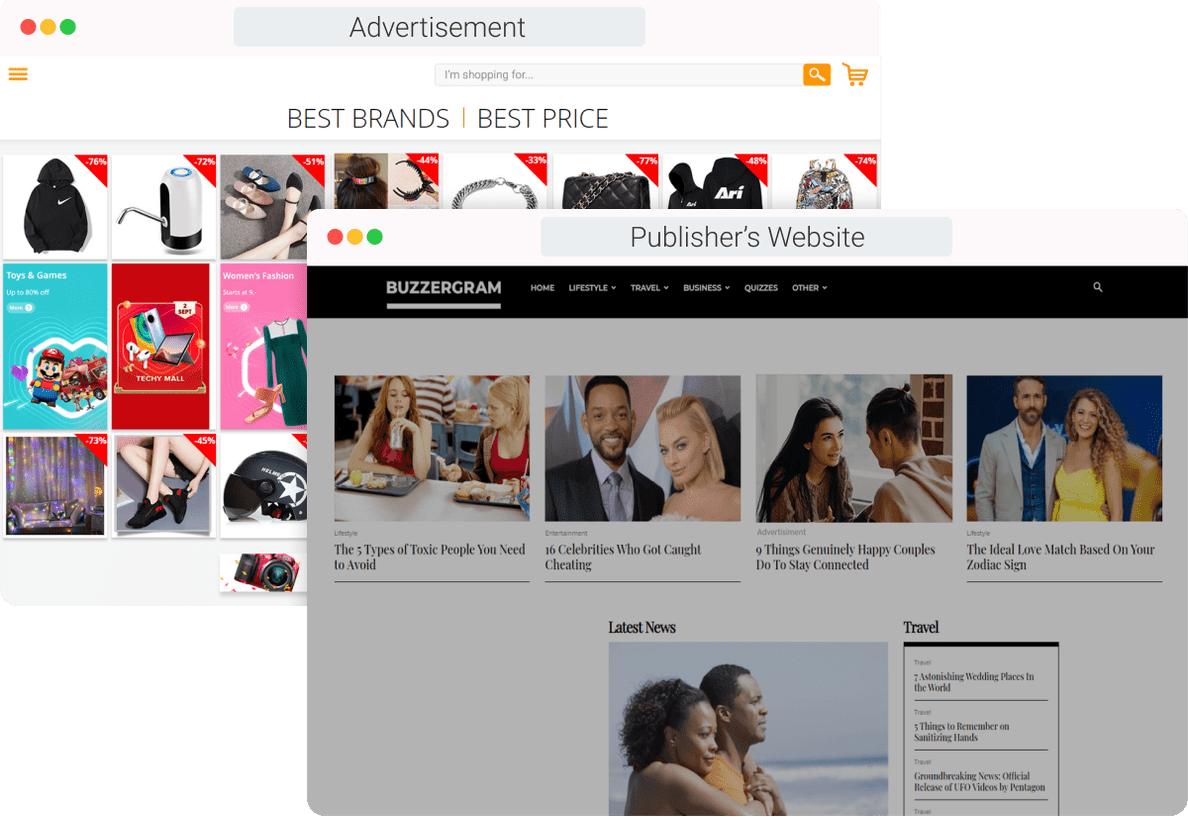
In-Page Push and Web Push
Web push is a browser advertising type that requires user consent and appears on the device once the consent is obtained. The best times of this format have gone, as users become intolerant to massive advertising in their browsers. Emerging technologies have given rise to new, in-page, formats that are more resistant to search engine bans and more effective in terms of clicks and revenues.

Video ads
Video ads, especially rewarded ads in mobile apps, show excellent CTR and retention, but they require solid hosting infrastructure and load-time optimization. Their complexity is a barrier for small and medium-sized publishers. Large brands, on the other hand, gain access to the highest payouts.
Video advertising is often classified into two main types: outstream video ads and in-stream ones. In-stream placements are the most engaging, since they appear in the content. You might have seen pre-roll, mid-roll, or post-roll ads on YouTube videos. Outstream video ads are placed outside video content and are less profitable, with some minor extra gains.
Some of the popular video ads subtypes: skippable and non-skippable in-stream blocks, bumpers, and masthead formats, which are native units on YouTube.
Smartlinks
One of the most effective options is doing without ads at all. How exactly? By placing Smartlinks. Smart Direct Links are nothing but URLs containing hundreds of relevant ad campaigns. Algorithms align what to show to a user depending on their preferences. In the end, publishers get refined ad feed while reaching more potential customers.
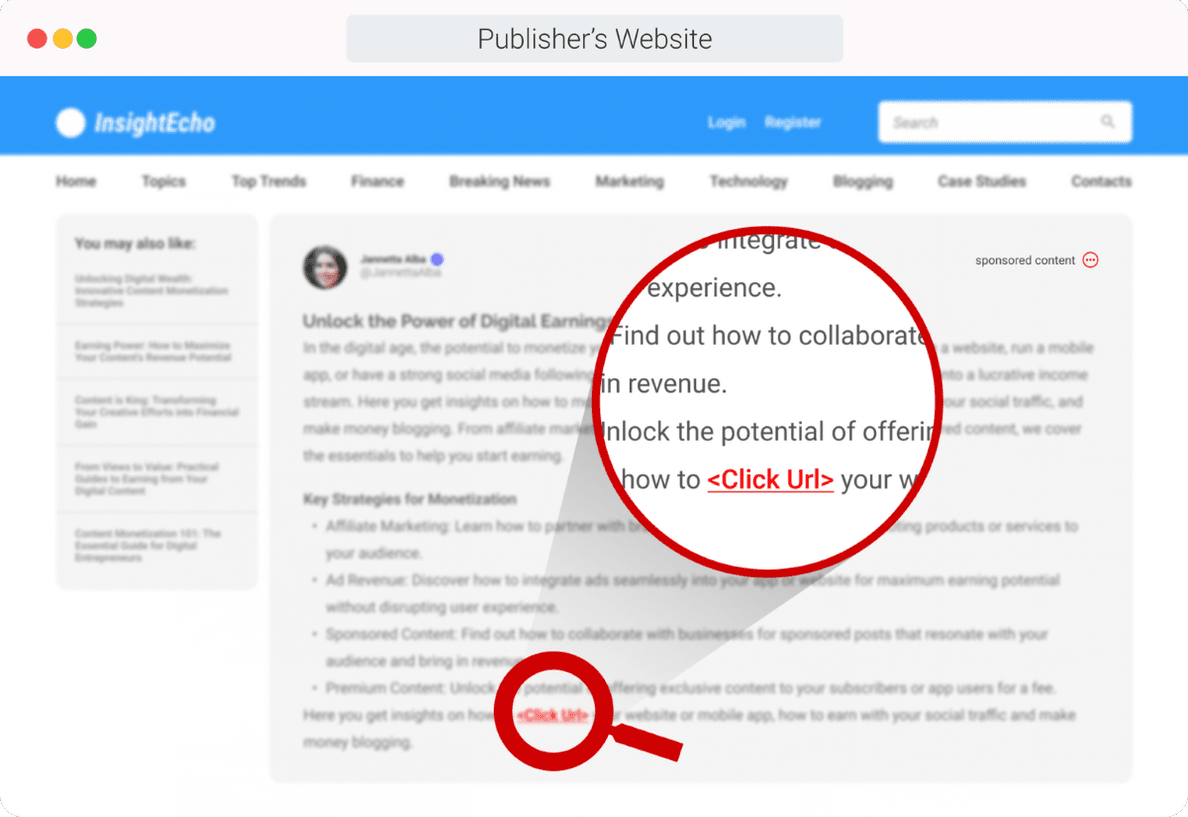
Interstitials
The most appealing full-page advertisement when it’s used the right way. Interstitials appear when users open a webpage or navigate to the next page: here’s where the name comes from, “inter-stitial”. Despite it’s size the ad is not intrusive, and doesn’t take extra space. A combination with Banners or Push can add some cash to your pocket.
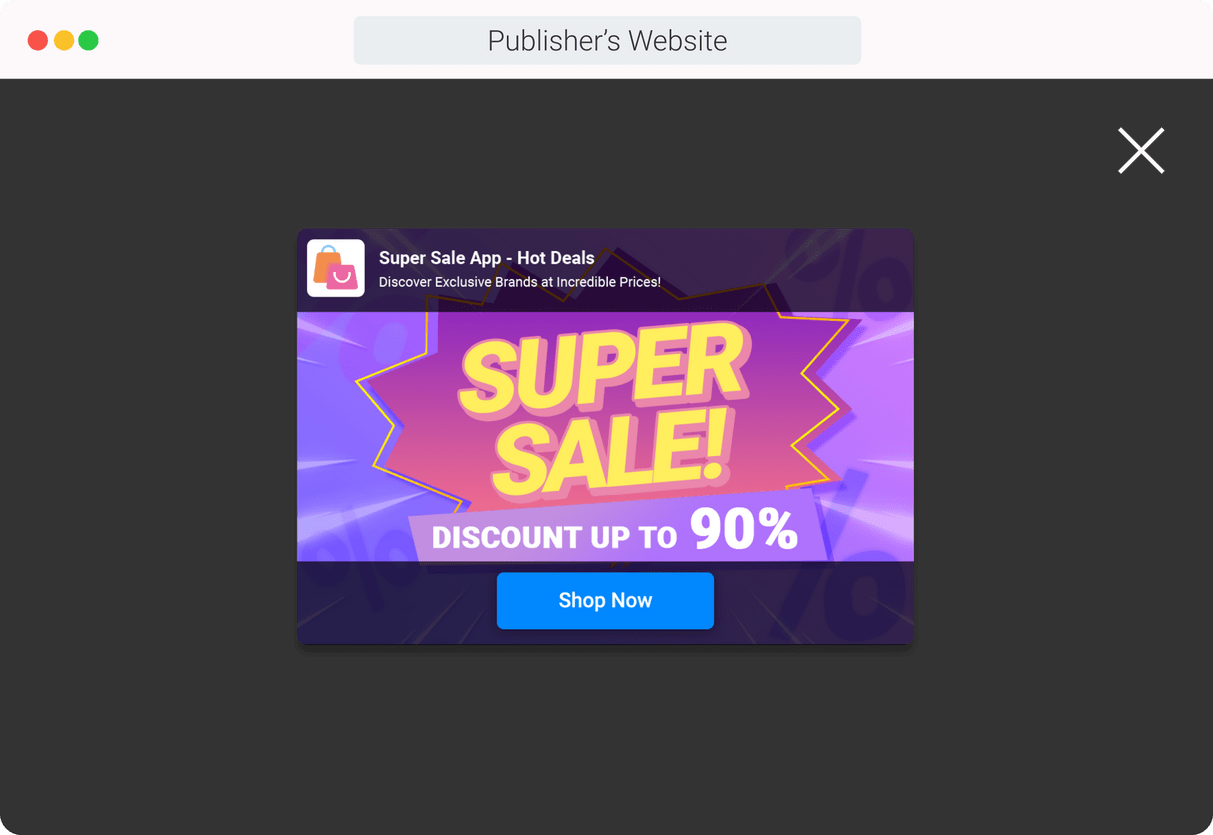
Social Bar
This unit aligns with the latest trends of user experience: a tendency to neat and friendly interfaces with no clutter in visuals. Innovative by design, Social Bar is a small overlay unit that resembles chat messages, widgets, or push notifications, ensuring ads look friendly and non-intrusive. Creative elements vary, making the ad look native and interesting. Tech-wise, Social Bar reminds sticky sidebar ads that remain visible as users scroll down a page, enabling prolonged exposure.
In short, you get paid for posting different ad formats which are viewed by different audiences, while addressing challenges that arise. You must find the best combo of your site’s layout and audience mindset. A blog with long-form content benefits from native and in-article placements, while entertainment portals thrive on Push, Interstitials, Video ads, and interactive formats.
Proven ad placement optimization techniques
Ad placement optimization stands on 4 pillars:
- page structure,
- user behavior data,
- ad unit choice
- and testing.
You’re not just placing ads, you’re predicting and managing attention flow.
Heatmap and scroll tracking
Tools like Hotjar and Microsoft Clarity reveal how users interact with your content. Adjusting ad size and location based on user intent increases visibility in the long run.
A/B testing
Rotate different ad formats and measure campaign results by total number of clicks, CTR, CPM, or RPM, and revenue. Use ad platform-specific statistics reports or dashboards. Adsterra’s stats allow you to filter traffic by placements and check how effective they are.
Viewability first
Place ads within the first visible viewport, above or within content, not buried in footers. You may blend advertising blocks with the main content to check if users click on ads. But if you start noticing higher bounce rates, it means user experience suffers from false clicks. Avoid this at all costs, as quality traffic is what both Google and monetization platforms like AdSense and Adsterra like the most.
Below-the-fold or even footer-based ads demand scrolling and have lower visibility. But they can provide additional income if the content is engaging, or if you place an anchor to valuable free assets placed at the end of the page.
Adaptive layouts or mobile formats
For mobile advertising, test sticky footers (don’t confuse with desktop footer banners) or floating ads. Responsive ad placement solutions ensure performance across screen sizes. As an alternative, use mobile-only sized if your ad platform doesn’t provide responsive designs.
Reduce ad fatigue
Robust ad networks can rotate various ad designs and looks, which prompts engagement and boosts clicks. But if you have to manage static ads yourself, experiment with placements using your own schedule (remember about the data-driven approach).
Publishers on AffLift have reported several times that even small changes like shifting a banner 100 pixels higher can enhance ad monetization by 15–20%. And finally, avoid oversaturating content to prevent banner blindness.
Advanced ad placement strategies to skyrocket earnings
Professional publishers often rely on multi-layered strategies that merge user analytics and innovative technologies. What can you borrow from them?
1. Behavioral placement
Use data from Google Analytics, Plausible, Matomo, or other solutions to track user behavior and align ad context with browsing patterns. When ads align with what people need (aka user intent), engagement grows naturally. Advertisers and publishers both profit from higher click-through rates.
2. Strategic ad placement via AI
Artificial intelligence tools analyze scroll depth, dwell time, and engagement metrics in real time, predicting the most effective ad placements. Tools, like Enhencer AI ads, allow you to adjust the look and the content of adverts on your inventory (mostly Shopify sites) and capture user attention.
3. Data-driven decisions
Implement network-specific dashboards showing CTR, ad spend, and performance metrics across multiple channels. This helps you identify wasted impressions and improve effectiveness and ROI. With multiple blogs, you can resort to Publishers’ API, facilitating control and ad management.
4. Audience segmentation
Group visitors by geography, device, OS, demographics, and interest. This allows precise targeting for both programmatic advertising and direct deals. Though ad targeting is not a publisher’s field, you can predict how advertisers select audiences and what will make them increase your CPM. For example, that’s how a movie website publisher easily discovered the countries from where the most lucrative traffic comes.
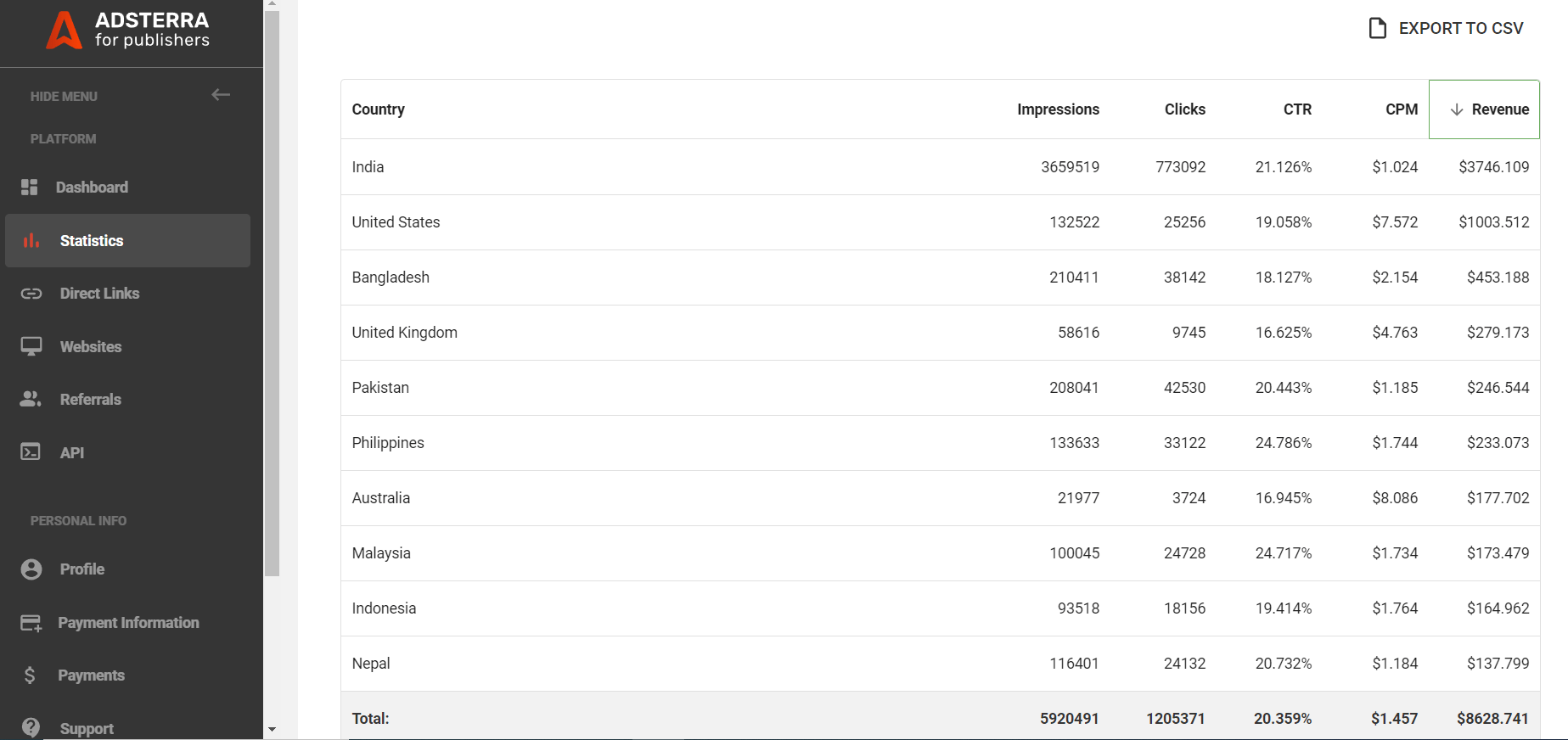
5. Smart refresh
Dynamic ad placement solutions enable banner refreshment when in view, increasing impressions without hurting UX.
Adsterra’s top-earning publishers ($20K) report that adjusting ad positions, smart ad combinations, and SEO skills can multiply your profits to the next level. Others say that adjusting ad position dynamically for desktop users versus mobile users improved overall placement effectiveness.
To wrap this chapter up: strategic placement is what makes the difference.
Ad placement by publisher niche: tailored strategies
Different verticals require tailored tactics. Placement tactics for a news site won’t work the same for a gaming blog. Let’s see how the main categories of publishers can use ad placements to monetize more.
News and aggregators
Readers scroll fast. Here’s why you need both: stop their attention on the homepage and catch them when they’re scanning the content.
Use sidebar banners, in-article native formats, and skyscrapers. Maintain trust by keeping ad relevance at a high level. Remember, you can apply customization, which means filtering out unwanted ad types at any time.
Entertainment and lifestyle portals
Combine Social Bar (Interstitials) and video ads formats to maximize visibility without slowing load times. If your blog is full of long-read content, explore Native adverts: they increase the likelihood of interaction.
Tech blogs and tools
Tech sites profit from mixing banners with push formats. They don’t normally use popups to retain user attention. Tech audiences are loyal to multiple banners when it comes to portals providing free tools or services: URL shorteners, file hosting, file downloads, WordPress plugins, etc.
Sports blogs
Sports audiences are used to seeing lots of ads: you can act a bit more aggressively, combining different ad placements. A workable mix is several slots for banners, one Social Bar, and a Popunder. But start safely, including these one by one after a short test. A cricket blogger from Pakistan finally left two formats only, maximizing ad revenue.
Gaming and app-based publishers
Gamers love video, that’s a fact. But you can rely on rewarded ads and mobile ad placement strategies that trigger during in-game pauses or achievements. Ad density on average sites should be kept below 30% to avoid disturbing visitors, but gamers are more tolerant to ads.
Affiliate and e-commerce inventory
Affiliate sites focus on strategic ad placement:
- Affiliate links come first near CTAs and product images.
- Additional ads like native blocks are woven into the content or bump between blog categories.
Marketplaces prefer catchy visuals like Interstitials. These vast overlay ads allow e-shops to use ad inventory efficiently while leaving opportunities to test different placements. All decisions are based on CTRs and conversions.
Each niche benefits from data-driven decisions and experimentation. Don’t copy layouts blindly; measure how ads reach the right audience and make gradual adjustments. Deliver valuable content, responding to real problems: this will excuse minor mistakes with placements.
Tracking ad placement success: KPIs and tools
No ad placement strategy succeeds without understanding how to measure the results. Advertisers use ad placement strategies for ROI growth. Publishers do the same to learn how ads perform and which slots waste space.
Key KPIs:
- Click-through rate (CTR): Measures engagement per impression. User interaction means a lot when you balance readability and profitability: false clicks damage your site’s health while low CTRs reduce revenues.
- Viewability: How often ads are actually seen. It’s important to gain insights from heatmaps and your ad platform.
- Effective earnings per thousand impressions eCPM: how much advertisers pay you per domain, placement, or in general. An alternative measurement is RPM, which counts revenue per page view.
- Bounce rate & session time: Indicators of placement impact on user experience and engagement.
- Revenue: the most important KPI, meaning how much you actually make. If the placement keeps sending you money, you put it as your priority.
Tools:
- Google Analytics or its analogs: Integrate ad performance dashboards.
- Adsterra or other platform’s stats page: Detailed analytics for CPM, CTR, and traffic quality.
- Heatmaps: Visualize user focus zones.
Monitor campaign performance weekly. Adjust your ad placement strategy if you see CTR drop or rising ad fatigue. The best publishers don’t guess — they iterate.
Your ad placement action plan: Key takeaways
How about a quick recap you can apply on different platforms, from sites to landing pages? Here you go:
- Start with one clear ad placement strategy per format, e.g., sidebar banner + Popunder. Check key measurements, then expand.
- Experiment with ad size when possible to find effective ad placements.
- Implement ad placement optimization tools like Hotjar, Mouseflow, and Crazy Egg, to spotlight poor-performing areas.
- Test different ad positions for desktop ad placements vs mobile users.
- Watch performance metrics and update regularly to maximize eCPM and ROI.
- Only add more ads if you’re sure page load speed won’t suffer.
- Iterate: don’t test multiple ad networks or formats at the same time, or your analysis won’t be clear.
- Optimize by manual intervention (reposition) or by asking your ad network’s manager to adjust the ad feed.
- Content-Ad ratio: when at the start, keep the balance of 30% ads and 70% content. After learning more about your visitors, change the ratio in the most beneficial way.
Remember, good placement is a cycle: test → analyze → reposition on a webpage → increase gains. The best ad placements prioritize the reader’s comfort and the publisher’s need for sustainable growth.
FAQs on ad placement strategies
What is the best placement for ads?
The best placement for ads depends on the site’s layout and audience behavior. Generally, above-the-fold banners, in-article native ads, and mid-content push placements deliver the best viewability and CTRs for most publishers. However, ads with no specific placements win in CPM rates: Popunders, Social Bar, and Interstitials.
What are the 5 M’s of advertising?
They stand for Mission, Money, Message, Media, and Measurement. Each ‘M’ defines how well an advertising campaign links up with audience intent, creative quality, and measurable efficiency (return on investment or cost per user acquisition). That’s how advertisers assess publishers’ inventory and decide on increasing or lowering CPM rates.
What are placement strategies?
Placement strategies define how you position and effectively integrate ads across site pages, formats, and devices to achieve higher engagement, lower fatigue, and better monetization performance.
Mastering ad placement strategies: Final line
Digital ad placements are all about strategic thinking and data. Ad exchanges and networks provide multiple tools to monitor, control, and optimize the way you display ads. Adsterra’s Statistics reveal how much you gain from each ad location, and you can filter traffic by device and OS type. Take a seat at your new workspace!
And remember: mastering ad placement strategies means understanding your audience, running ads with purpose, and making data-driven changes. Reach the right audience and keep users engaged for the long haul with Adsterra!
